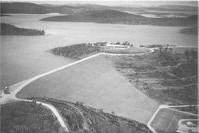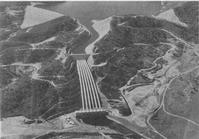


Chapter 6
I Construction During The Settlement Years
II The Use Of Timber As A Structural Material
III Structural Steel
IV Concrete Technology
V Housing
VI Industrialised Pre-cast Concrete Housing
VII Ports And Harbours
VIII Roads
IX Heavy Foundations
X Bridges
XI Sewerage
XII Water Engineering
XIII Railways
XIV Major Buildings
XV Airports
XVI Thermal Power Stations
XVII Materials Handling
XVIII Oil Industry
XIX The Snowy Mountains Scheme
XX The Sydney Opera House
XXI The Sydney Harbour Bridge
XXII Hamersley Iron
XXIII North West Shelf
Sources and References
Index
Search
Help
Contact us

Proposals for utilising the waters of the Snowy River to supplement the summer flows of the inland rivers, the Murray and the Murrumbidgee, dated back to the 1880s. These proposals were in the context of additional water supplies to relieve the all too frequent inland drought conditions.
From 1908 the Snowy River was examined also from a different aspect, that is the harnessing of the Snowy's waters for hydro-electric power production. Various proposals followed, involving the States of New South Wales and Victoria, and the Commonwealth. This culminated in the setting up in 1947 of a joint Commonwealth-States Technical Committee to investigate the whole question of the possible use of the Snowy River.
As a result of the recommendations prepared by the Technical Committee, the Commonwealth Government in 1949 passed the Snowy Mountains Hydro-electric Power Act. In doing so, it established the Snowy Mountains Hydro-electric Authority as the body responsible for the detailed investigation, design and construction of the dual-purpose Snowy Mountains Scheme.
The Scheme stands as a tribute to the men who had the foresight and courage to initiate the construction of what became the largest single engineering project ever undertaken in Australia. In an area of over 3,200 square kilometres of mountainous country the Authority constructed some 80 kilometres of aqueducts, over 140 kilometres of tunnels, 16 large dams, a pumping station, and seven power stations, two of which are underground (Figs. 74 and 75). Hundreds of kilometres of transmission lines interconnect the power stations and transmit electricity to the supply systems of New South Wales and Victoria.


Briefly, the Snowy Mountains Scheme diverts the waters of the Snowy River and its tributary, the Eucumbene, through two trans-mountain tunnel systems driven westwards under the Divide to feed the two inland rivers, the Murray and Murrumbidgee, with increased supplies of water for irrigation expansion in their valleys. In their passage the waters fall 800 metres, through shafts, tunnels, and power stations to generate peak-load electricity for the Australian Capital Territory, New South Wales and Victoria.
The cost of the Scheme was approximately $820,000,000. Revenue from charges associated with the supply of electricity will meet all costs, including interests, repayment of capital, and maintenance and operation of its works. No charge is made for the supply of water to the States for irrigation.
To gain a proper appreciation of the Snowy Scheme, it should be considered from two aspects. The first of these is its role as a source of supplementary peak-load power feeding into the inter-connected power grid system of New South Wales and Victoria -power to light thousands of homes and supply the needs of industry in the eastern cities. The total generating capacity is 3,740,000 kilowatts.
People in Bright Sparcs - Price, Douglas G.
 |
Australian Academy of Technological Sciences and Engineering |  |
© 1988 Print Edition pages 420 - 421, Online Edition 2000
Published by Australian Science and Technology Heritage Centre, using the Web Academic Resource Publisher
http://www.austehc.unimelb.edu.au/tia/422.html